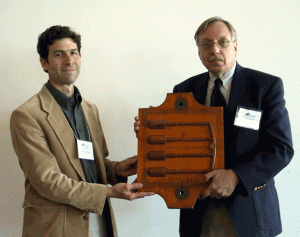Vogel Prize 2004 – Philip Lord, Jr

2004 Robert M. Vogel Prize Winner – Philip Lord, Jr (right) with Rick Greenwood (left) Photograph by Perry Green
Robert M. Vogel Prize Committee member Rick Greenwood made this year’s presentation on behalf of the committee chair, Tim Tumberg, who could not attend. (The following is from Mr Tumberg’s prepared text.)
“Although this award has been presented every year except one since 1982, this year marks only the third presentation of the Robert M. Vogel Prize. For the first two decades of its existence, the award was called the Norton Prize, thanks to the sponsorship of the abrasives manufacturing company from Worcester, MA. After the Norton Co. decided to discontinue their financial support of the award in 2001, the SIA Board quite rightly opted to rename the prize in honor of Robert M. Vogel, in recognition of his role as one of the Founding Fathers of the SIA and of his many contributions to the society.
“As most of you are probably aware, this award is given annually to the author (or authors) of the outstanding scholarly article published in IA: The Journal of the Society for Industrial Archeology over the past three years. Current guidelines stipulate that: “articles under consideration must have a clearly stated thesis, a well constructed narrative, and an understandable conclusion. The analysis of material culture plays an important role in articles considered for the prize, as does the use of high_quality illustrations.” I would like to thank committee members Larry Gross, Rick Greenwood, David Landon, and Lance Metz for their thoughtful analyses of the articles under consideration for this year’s prize. After several rounds of deliberation, the committee selected Philip Lord Jr.’s article titled “The Covered Locks of Wood Creek” as the winner of the 2004 Vogel Prize.
“Lord’s article is a seminal research piece that interprets the early beginnings of navigation improvements in the United States. As historian George Rogers Taylor has made clear, the industrial revolution in the US could not have been possible without the earlier transportation revolution. The earliest component of this is the creation of river improvements and towpath canals. Perhaps the most important focal point of these waterway improvements was the Hudson- Mohawk Corridor in New York State. This region was the only water level geographic gap in the Appalachian Mountains which separated the East Coast from the fertile lands around the Great Lakes and Mid-West. As such the Hudson-Mohawk Corridor attracted the attention of entrepreneurs and engineers and became the cradle of America’s canal era. These conclusions are accredited to Philip Lord using the best available historical and archaeological research tempered with his many years of experience exploring this area.
“Without further ado, Philip Lord please come forward to receive the 2004 Robert M. Vogel Prize.
The assembled members applauded Mr Lord who came to the podium to receive the prize and commemorative foundry pattern display. He thanked the society, adding that he was very pleasantly surprised by the award and was glad that the notice wasn’t e-mail spam or a prank phone call. He was glad to hear the quality of the papers given at the morning sessions today. His first job was in Providence in 1962 collecting information for the city directory. He retired from the New York State Museum 18 months ago to continue teaching. Out of all the things he has published, he said the article which won the award is the one of which he is the most proud because of the quality of the SIA Journal and its audience.

